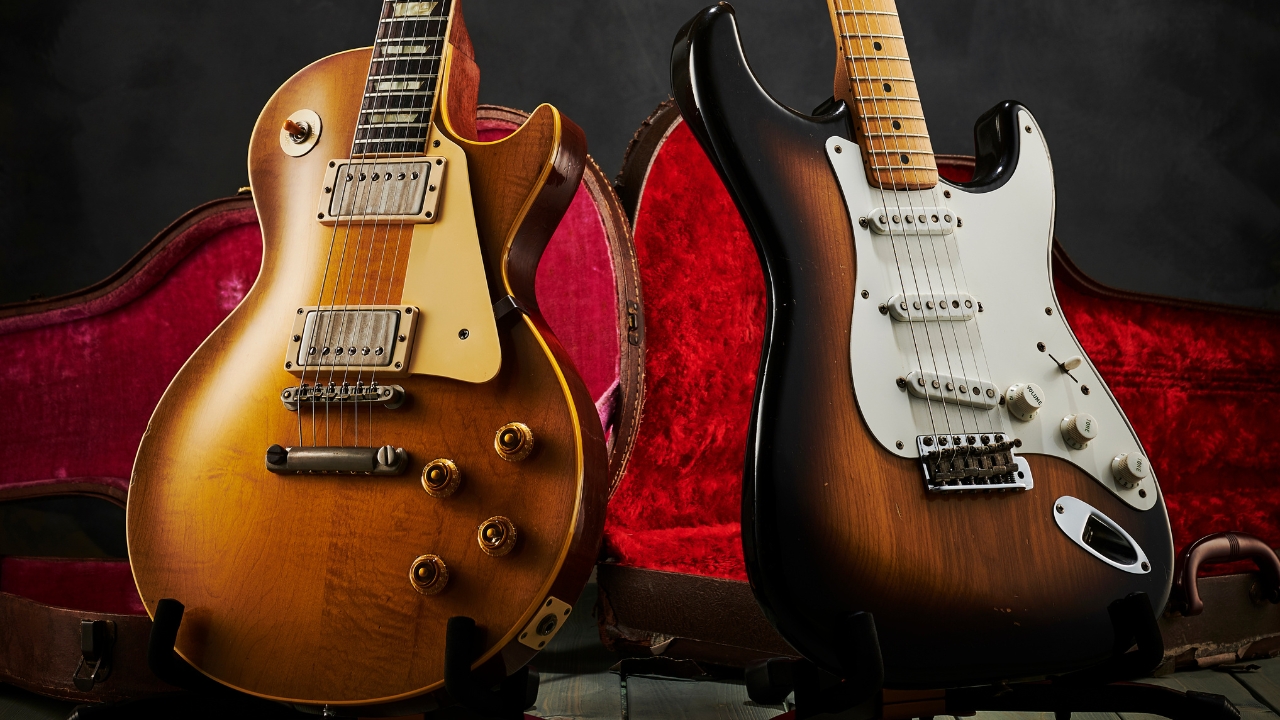
Are there two more iconic guitars than the Gibson Les Paul and the Fender Stratocaster? We’d wager probably not. These two behemoths of music history have consistently found themselves in the hands of the world's best guitar players ever since their inception in the early ‘50s – and their popularity hasn’t waned in the slightest since then.
Deciding between the two can be an immeasurably difficult choice, kind of like trying to pick your favorite out of Jimi Hendrix and Jimmy Page. History tells us they’re both superb instruments in their own right, so to make your decision easier, we’ve broken down each instrument's best - and worst - characteristics so you can decide for yourself.
Gibson Les Paul vs Fender Stratocaster: At a glance
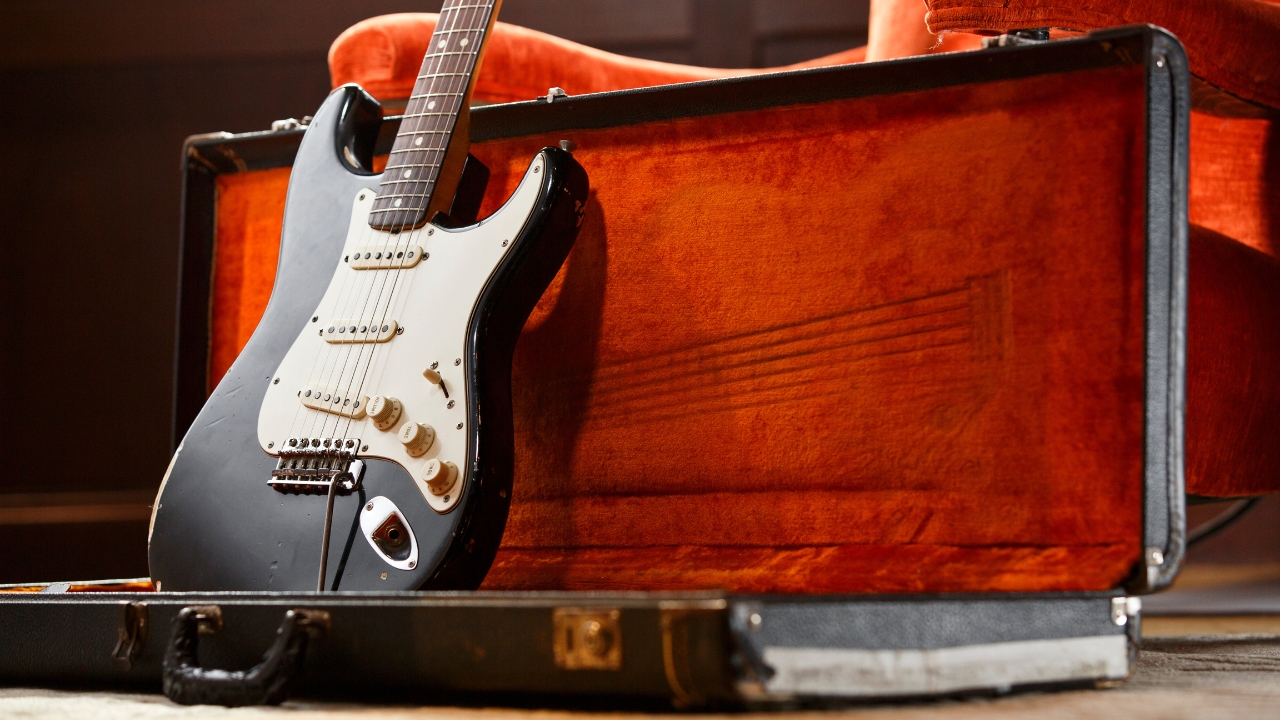
There are a lot of iterations of both the Les Paul and Stratocaster, so for this direct comparison, we’ve opted to go for two models that embody the classic specs of each, the Gibson Les Paul Standard 50s and the Fender American Vintage II 1957 Stratocaster. Both are based on classic designs from the same era and contain all the core features that made these guitars so popular in the first place.
Gibson Les Paul Standard 50s
- Body: Mahogany w/ Maple top
- Neck: Mahogany
- Scale Length: 24.75"
- Fingerboard Radius: 12”
- Nut Width: 1.694”
- Neck Shape: 50s Vintage
- Pickups: Burstbucker
- Contact: Gibson
Fender AV II 1957 Stratocaster
- Body: Alder
- Neck: Maple
- Scale Length: 25.5”
- Fingerboard Radius: 7.25”
- Nut Width: 1.650”
- Neck Shape: 1957 ‘V’
- Pickups: Pure Vintage '57 Strat
- Contact: Fender
Gibson Les Paul vs Fender Stratocaster: Design & Hardware
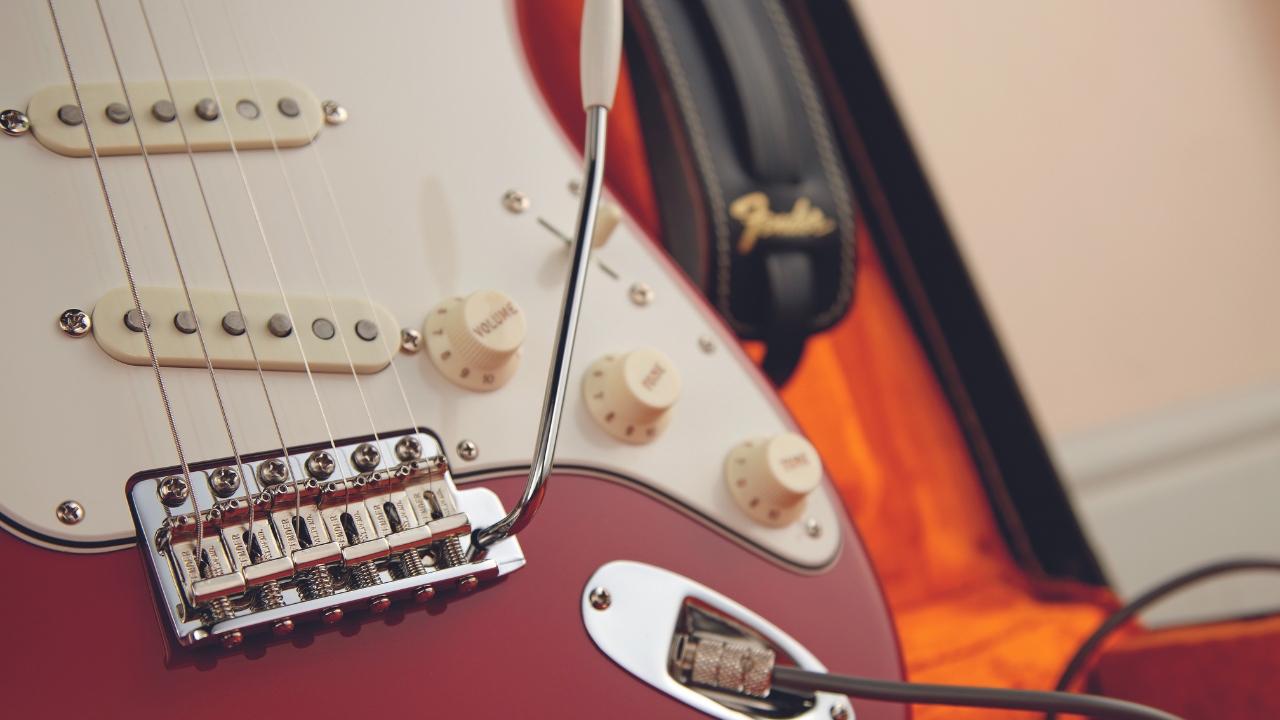
The Strat and Les Paul are quite opposed when it comes to hardware and design. The Les Paul is made from solid Mahogany and features a Maple top or veneer, which results in a guitar that is a lot heavier than a Strat. The top of a Les Paul is also carved, which means it's rounded on top. The Strat meanwhile, is constructed from an Alder or sometimes Ash solid body and typically doesn’t have a top. The construction is flatter and generally uses less wood than a Les Paul, with all of these combining to make a guitar that is much more lightweight.
The Les Paul has a Mahogany neck which is ‘set’ into the body using a tenon joint and glue. This connection with the neck and the body, combined with the same material in both is an inherent part of the Les Paul sound, contributing to its legendary sustain. The Fender Strat has a simpler design, with the neck being bolted to the body by four (or in rarer cases three) bolts. Whilst this means there are no extra sustain properties, it does make it much easier to replace the neck if necessary, something that’s quite difficult with a Les Paul.
Fretboards on Les Pauls tend to be Ebony, while a Strat is more likely to have a Rosewood or Maple ‘board. These can differ from guitar to guitar, however, so are just the most commonly found combinations rather than an absolute rule. Again, there’s a lot of variety in neck profiles but a classic Strat neck will be thinner than that of the Les Paul, which tends to have a chunkier profile. In a similar way radius can vary a lot but generally, a Les Paul will have a flatter, 12-inch radius, whereas a Strat will have a rounder 7.25” to 9.5” radius.
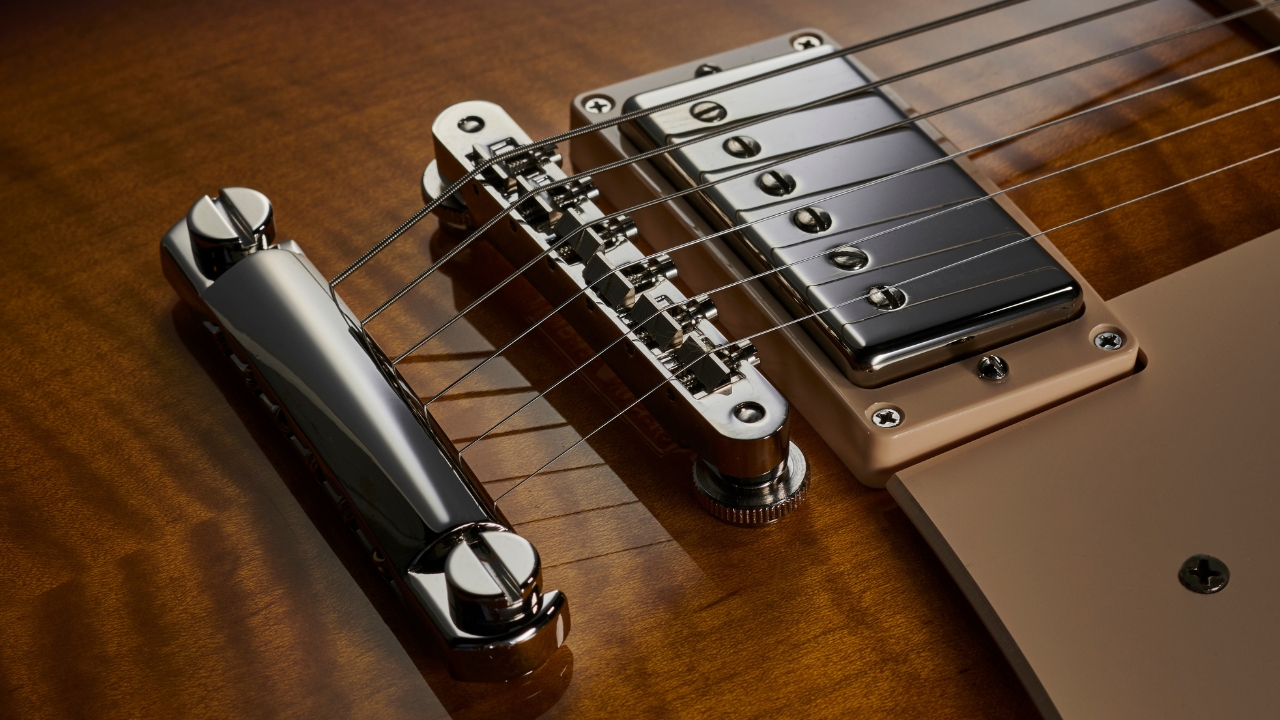
The scale length, that is the distance between the nut and the bridge of both guitars, also differs. On a Strat, you’ll find a longer, 25.5” scale length whereas the Les Paul features a 24.75”. This may not seem like much on paper, but it definitely affects the playability of each guitar quite a lot - more on which later.
Both guitars feature different headstock designs too. The Strat has a six-in-a-line arrangement when it comes to tuning machines, whereas the Les Paul features a 3x3 design. The Les Paul uses a headstock that’s angled backward to create a break angle as the strings go over the nut, but the Strat has a flat headstock, utilizing string trees to help the break angle, which is vital to the guitar’s tone. One criticism of the Les Paul here is that the angled headstock means they break more easily than the design on the Strat.
A Les Paul has a tune-o-matic bridge, which is raised from the body whereas the Strat has a six-saddle bridge - usually with a tremolo - that ‘floats’ flush with the body. This floating design allows you to adjust the pitch of the strings, but can also cause tuning instability. The Les Paul bridge is a hardtail, which typically delivers sturdier performance when it comes to stability. A tune-o-matic bridge is normally slightly curved to match the radius of the fretboard whereas a Strat bridge will be flat, with the individual saddles being raised more in the middle to take account of the neck radius.
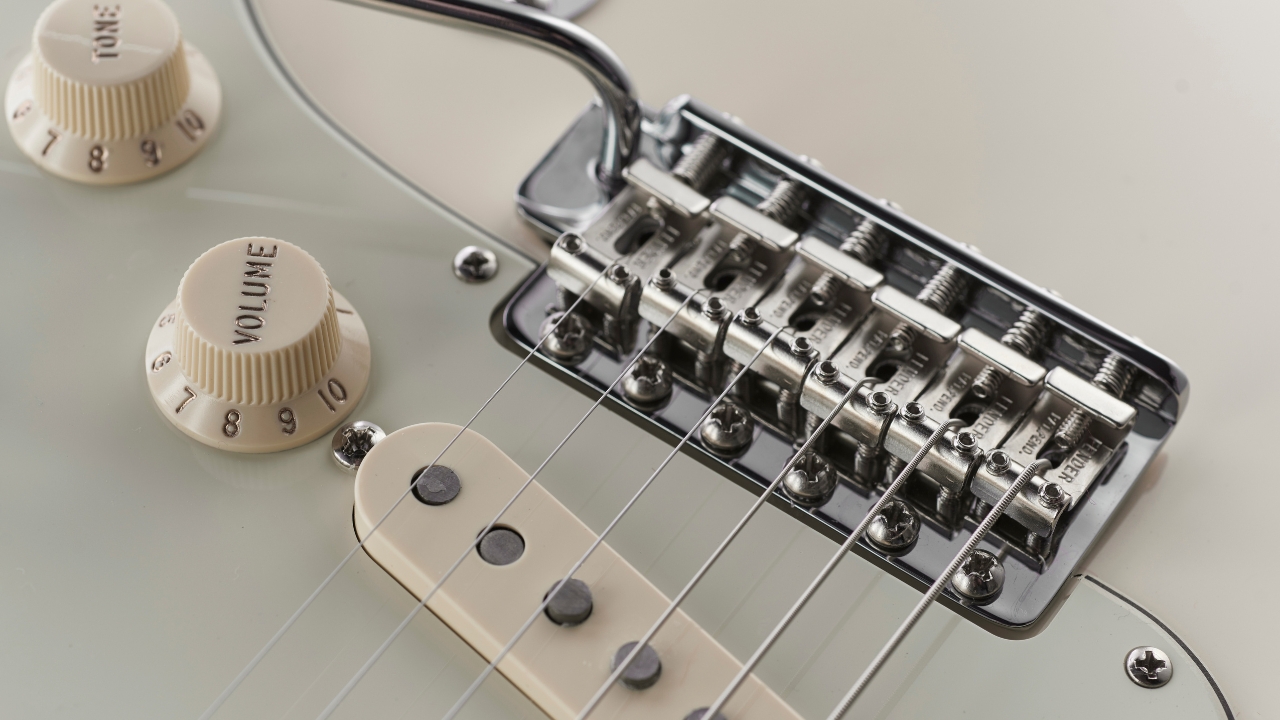
Arguably the Strat bridge is a little more flexible when it comes to setting up, as you’ve got more room to maneuver the saddles to adjust the intonation and action whereas the Les Paul relies on two thumbscrews and has slightly less front-to-back movement via the saddles. The differences here are fairly small though and neither bridge design is likely to cause you any problems in setting up and getting your guitar intonated.
Finally, let's look at the electronics of each guitar. A Les Paul usually features two humbucker pickups with a three-way toggle switch, whereas the Strat has three single coil pickups and a five-way pickup selector. A Les Paul will have two volume controls and two tone controls, one for each pickup. The Strat meanwhile has a single master volume and two tone controls, with one handling the neck and middle pickup while the other controls the bridge. Once again, with so many variations on these popular platforms, these can differ greatly from guitar to guitar. Many modern iterations of the LP and Strat will feature out-of-phase wiring, treble bleed circuits, and push-pull tone knobs.
Verdict: Draw
There’s no separating these two when it comes to design and hardware. Both do a very similar thing in different ways, each having its positives and negatives that will come down to a player’s personal preference. Ultimately these are two time-tested guitar designs that will benefit any kind of guitar player, just in their own unique way.
Gibson Les Paul vs Fender Stratocaster: Playability
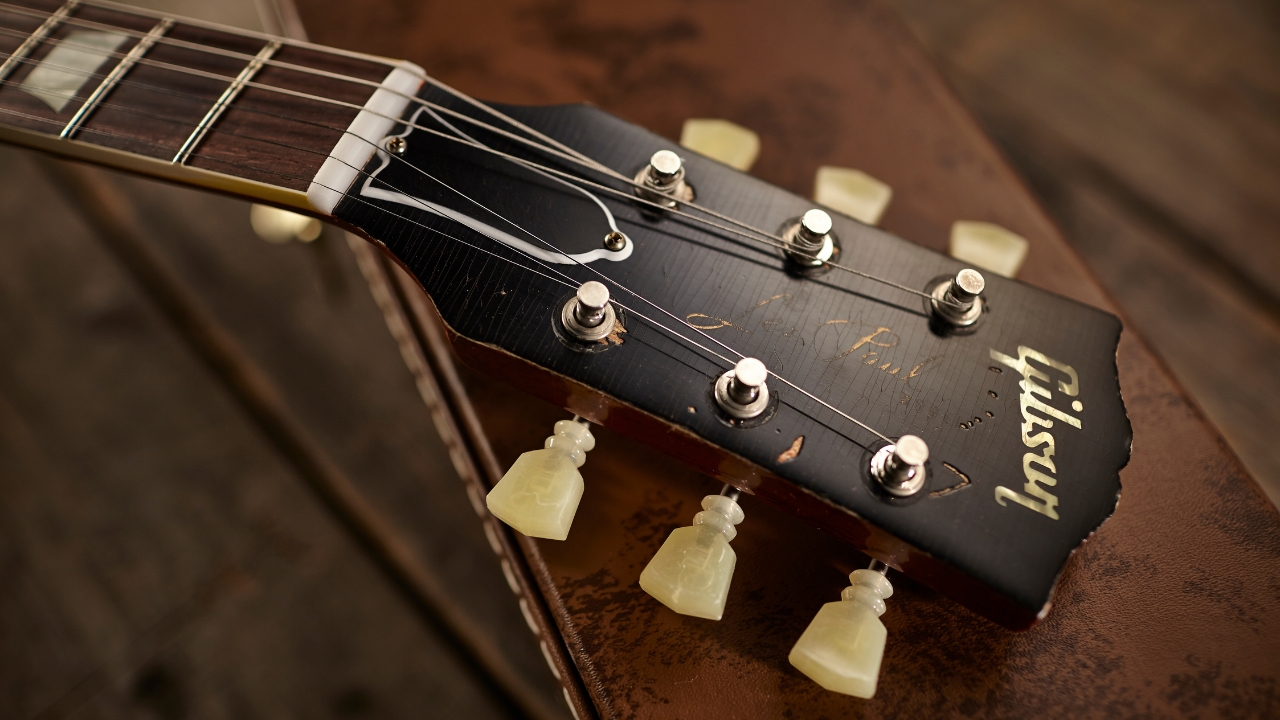
As we mentioned before both guitars feature different scale lengths, which affects the way each plays. The Les Paul has a shorter 24.75" scale length, which means you can fit thicker strings without upping the tension too much. For this reason, the Les Paul has a reputation for being easier when bending the strings, but this isn’t strictly true. The Strat's longer 25.5" scale can be just as easy to bend as a Les Paul if you fit a smaller gauge of string on it.
The scale length difference means you can fit a thicker set of strings on a Les Paul with less tension, which will deliver a little more sustain. To get equal performance on both, you would typically fit a set of strings that is one step thicker to equal out the performance. So a set of 10s on a Les Paul will feel like a set of 9s on a Stratocaster.
A classic Les Paul usually has a thicker neck profile compared to a Strat, which can make them feel unwieldy at first if you’re used to something thinner. This isn’t something that players can’t get over with time, but ultimately it comes down to personal preference. There’s no reason you can’t shred or bend wildly on either with a nicely set up instrument.
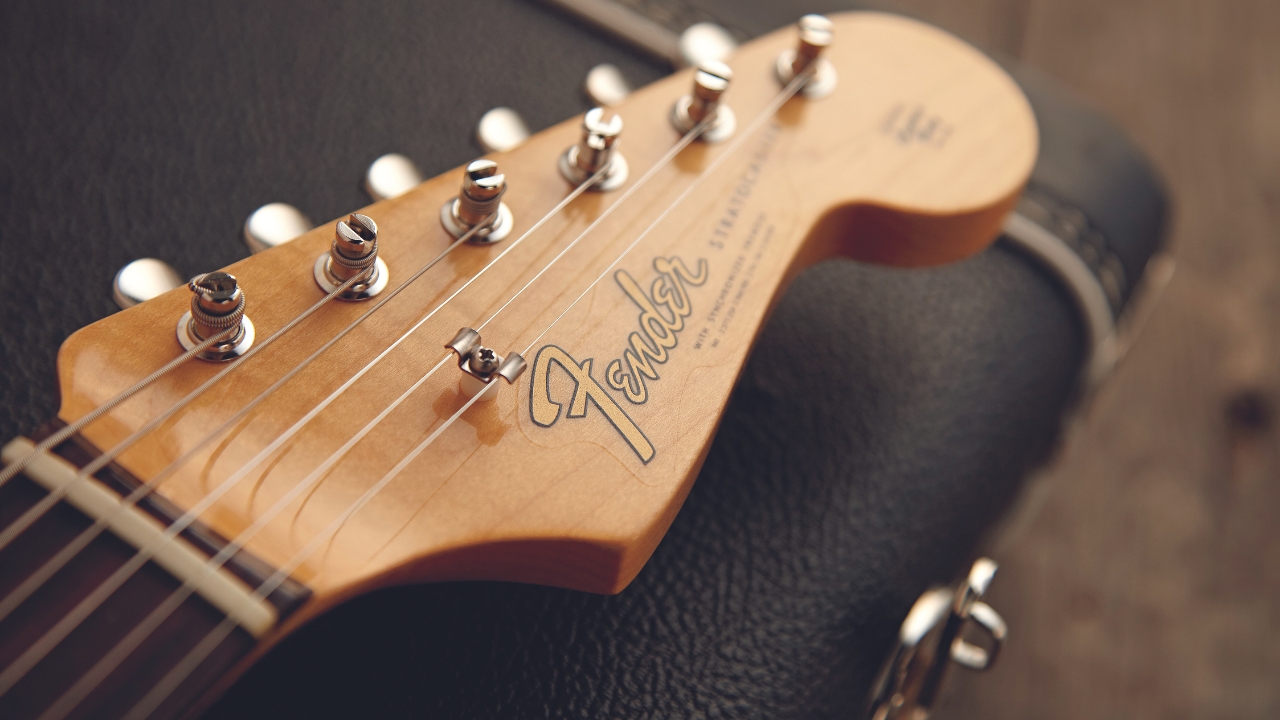
The profile of the neck works in tandem with the radius which also affects playability, The Les Paul's flat 12-inch radius is generally considered to be better for bends and single-note playing. A Strat will usually have a 7.25” to 9.5” radius which is more round, and typically more comfortable for chord work. To be totally honest here, they just feel different, and depending on your own playing styles and tendencies, you may feel the total opposite is true for each guitar.
A traditional Les Paul is a lot heavier than a Strat, which means when playing standing up you’ll really feel the weight of it on your shoulder and back. There have been cases of guitarists playing for many years reporting back problems, like Trivium’s Matt Heafy, due to the hefty weight of a Les Paul, so getting a wide, good-quality guitar strap is a must. More modern versions of the LP feature weight relief, where the body is chambered to reduce the weight.
The differences in bridge design can also change the feel in terms of playability. With the tune-o-matic design being away from the body, some players can take a little time to get used to the position when coming from a Strat bridge that allows you to rest your hand on the guitar body. Again, there are no deal breakers here on each, as it's simply a difference in feel rather than actual playability.
Verdict: Draw
You’ll be able to get away with playing a whole host of techniques on each of these guitars, so we’re going to call it a draw again. Both guitars take very different approaches to their playability, but ultimately each plays fantastically well.
Gibson Les Paul vs Fender Stratocaster: Tone
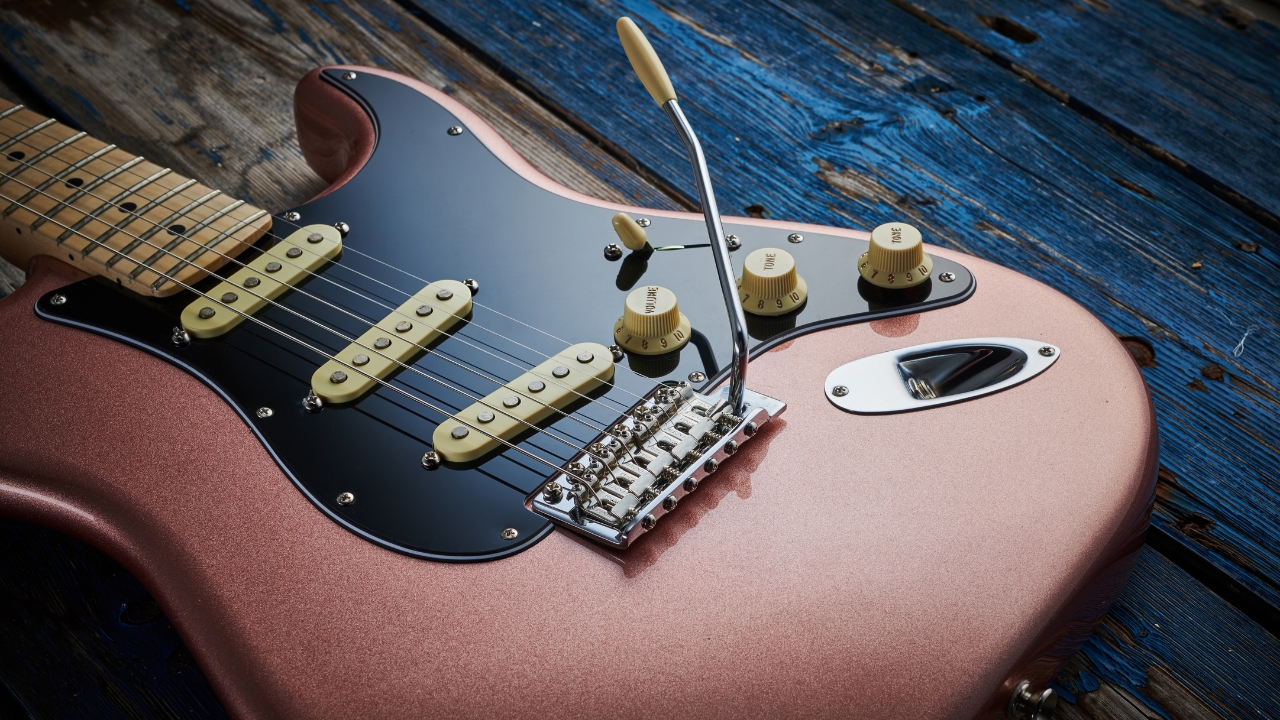
Both guitars are vastly different from one another when it comes to tone. The Stratocaster is known for its slinky, spanky guitar tone that’s more sharp and cutting, whereas the Les Paul is all about pure power. They couldn’t sound more different, which is all part of the appeal each has for particular players.
The Strat features three single coil pickups that give it a bright and distinctive tone, with plenty of flexibility when it comes to tonal changes thanks to a 5-way pickup selector. In the bridge position, you get lots of trebly goodness, which will cut through dense mixes like butter. Switching to the neck position, a Strat will give you a warm and thick tone that’s lovely and mellow.
The middle position is really underrated in our opinion, and gives you the best of both the neck and bridge positions with a balanced and focused tone that’s super versatile. You can adjust this nicely with the two tone knobs to create your perfect balance. Then you have two ‘in-between’ positions, which can be described as quacky, honky, and a myriad of other descriptors. It gives you the sound of both the bridge and middle pickup, or the neck and middle pickup, and is one of the Strat's signature tones, great for funky chords.
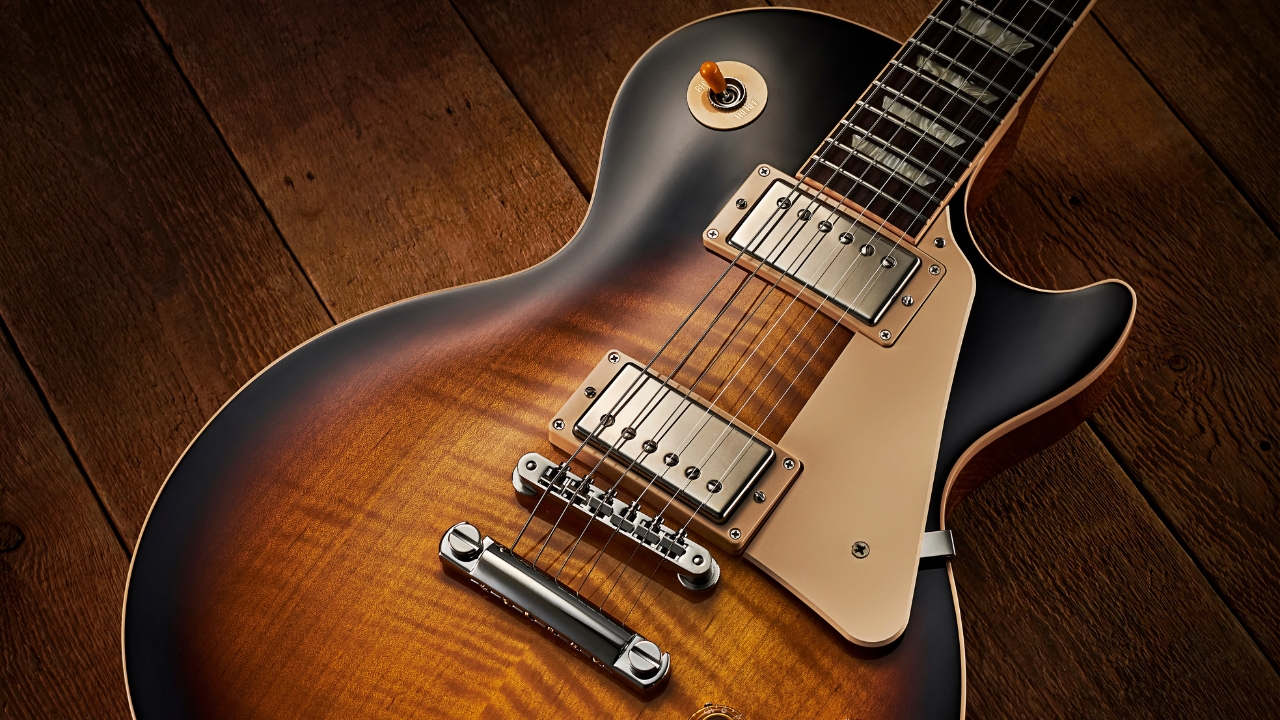
The Les Paul has a slightly different setup, with two humbuckers and a three-way toggle switch for selecting your pickups. Like a Strat the bridge position is brighter and the neck pickup darker, but a Les Paul has a lot more power and midrange energy than the Strat in both of these positions. The sustain on a humbucker is also much greater, so your notes and chords will take longer to ring out.
While not quite as cutting as the equivalent on a Strat, the bridge position on a Les Paul has a lovely bite to it whilst still retaining plenty of fullness. The neck pickup sounds a lot warmer, with a luscious, thick tone that lends power to chords and single-note riffs. The middle position combines the best of both these pickups but is even more flexible, as you can balance the tones of each using the separate volume and tone controls.
While the Les Paul doesn't have quite as many different sounds as a Strat, we wouldn't say that it's to its detriment. The pure simplicity of a Les Paul is something that has been often praised by guitarists, allowing you to quickly dial in a great tone with a minimum of fuss.
Verdict: Draw
Both guitars have ultra-versatile tones that can be used on a huge variety of different styles. You may want to call us out for sitting on the fence here, but we can’t call this anything other than a draw. Once again each guitar goes about its business differently, providing a unique sonic character that has equal benefits and drawbacks.
Gibson Les Paul vs Fender Stratocaster: Verdict
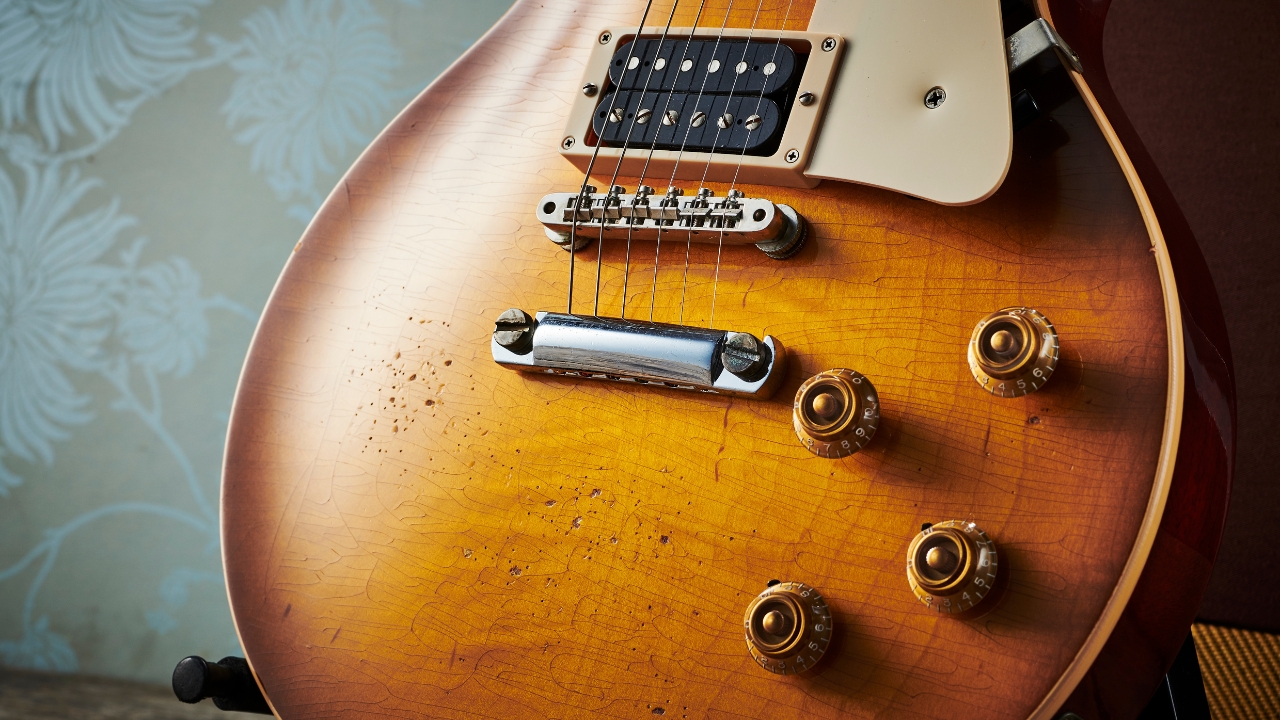
We called it a draw in all three categories here, which just goes to show how hard it is to separate these two colossal guitar giants from one another. Despite not being particularly similar in terms of design ethos, playability, and sound, they both still managed to become legends in their own right. Both are fantastic playing platforms that can cover a range of styles and despite their differences, you'll find most guitarists will have favorable things to say about each.
So which should you choose? Well, that's a decision only you can make. We’d recommend playing one of each before making your decision. Both are very different feeling and sounding guitars but only you can decide which one is best for your particular set of sonic circumstances. In an ideal world, we’d have one of each!
Gibson Les Paul vs Fender Stratocaster: Recommended models
As close to the original guitar as most of us are likely to get, the Gibson Les Paul Standard 50s is as period-correct as it gets, from the larger, 50s style neck profile to the correct angle for the headstock.
Sitting in the mid-range in terms of price, the Epiphone Les Paul Modern is a fantastic looking and playing instrument, that won't cost you the earth. It still packs that fearsome LP tone though, with bags of grit and never-ending sustain.
If you're a beginner guitar player and you must have an LP guitar like Slash, then Epiphone Slash 'AFD' Les Paul Special features the trademark tones and looks of the Gibson model, without the associated weight or similarly hefty price tag.
An incredibly accurate recreation of an original instrument from 1957, this American Vintage II Strat features a period accurate body, neck profile, and hardware, even down to a very specific voicing for the pickups.
One of Fender's most popular offerings, the Fender Player Strat offers a genuine Fender Strat at a much more affordable price. Praised for it's value for money, excellent playability, and modern features, it's the perfect mid-range Strat.
One of the most popular beginner guitars ever manufactured, the Squier Affinity Stratocaster has been the starter for many guitar players, combining the classic Strat sound and playability in a phenomenal value for money package.







